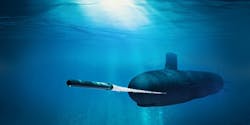Navy asks Lockheed Martin to continue upgrading Mark 48 torpedo guidance and sonar for lethal performance
WASHINGTON – U.S. Navy submarine warfare experts are asking Lockheed Martin Sippican Inc. in Marion, Mass., to upgrade sonar and guidance systems on the submarine-launched Mark 48 torpedo under terms of a $105.7 million order announced Friday.
Officials of the Naval Sea Systems Command in Washington are asking Sippican to provide new guidance and control sections, as well as sonar upgrade kits, for the Mark 48 Mod 7 torpedo, which is standard armament for the Navy's fleet of Los Angeles-, Virginia-, and Seawolf-class fast attack submarines, as well as Ohio-class ballistic- and cruise-missile submarines.
Sippican will provide Common Broadband Advanced Sonar System (CBASS) upgrades, MK 48 Mod 7 heavyweight torpedo guidance and control sections, and related engineering services, Navy officials say.
The Lockheed Martin Corp. Rotary and Mission Systems segment is building the Mark 48 Mod 7 CBASS heavyweight torpedo with advanced common broadband advanced sonar system for expanded operational capabilities for shallow waters along coastlines and inside harbors, as well as in the deep-water open ocean.
The CBASS broadband sonar enhancement makes the torpedo more effective against new enemy submarines in the harshest of acoustic environments, Lockheed Martin officials say.
The Mark 48 Mod 7 CBASS torpedo uses modern commercial-off-the-shelf (COTS) technologies in an open-architecture computing environment, and can be improved with regular hardware and software upgrades, Lockheed Martin officials say.
The Mark 48 Mod 7 CBASS kit’s evolutionary design and modular nature makes the upgrade of older version Mark 48 torpedoes to the Mod 7 CBASS capability a relatively straightforward effort without requiring significant torpedo redesign and certification, Lockheed Martin officials say.
The CBASS torpedo also has the ability of multiband operation with active and passive homing; advanced counter-countermeasure capabilities; effectiveness against low-Doppler shallow submarines, fast deep diving submarines, and high-performance surface ships; autonomous fire-and-forget operation or wire-guide capability to enable post-launch monitoring and updates via the submarine combat system; and running Otto Fuel II as the propellant.
The Mark 48 Mod 7 CBASS provides the ability to transmit and receive over a wide frequency band and use broadband signal processing techniques to improve the torpedo’s search, acquisition, and attack effectiveness, Lockheed Martin officials say.
The Mark 48 torpedo is 19 feet long, 21 inches in diameter, and weighs 3,500 pounds. It can be used as deep as 1,200 feet at distances as far as five miles. The torpedo can travel as fast as 28 knots and has a 650-pound high-explosive warhead.
On this order Sippican will do the work in Syracuse, N.Y.; Clearwater, Fla.; and in Marion and Braintree, Mass., and should be finished by December 2025. For more information contact Lockheed Martin online at www.lockheedmartin.com, or Naval Sea Systems Command at www.navsea.navy.mil.
About the Author
John Keller
Editor-in-Chief
John Keller is the Editor-in-Chief, Military & Aerospace Electronics Magazine--provides extensive coverage and analysis of enabling electronics and optoelectronic technologies in military, space and commercial aviation applications. John has been a member of the Military & Aerospace Electronics staff since 1989 and chief editor since 1995.
